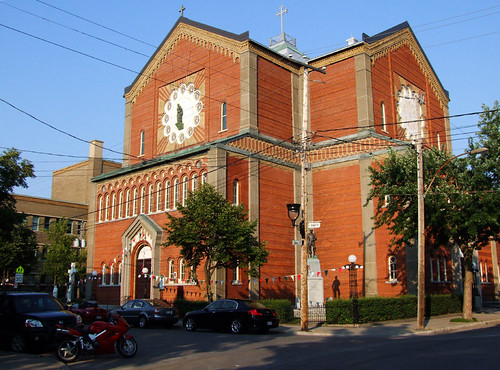Whenever I head up to Little Italy, on my way for a coffee at Caffè Italia or some gelato at the Jean Talon Market, I wonder about Dante Street, a fairly short sidestreet off St. Laurent Boulevard just below the market. Although it is quiet, Dante Street is home to a few Little Italy landmarks, including the Pizzeria Napoletana and the sumptuous redbrick Chiesa della Madonna della Difesa, in which you can find a fresco of Benito Mussolini painted in 1919.
What really gets me about Dante Street is its name, however. A quick look at Quebec’s toponymy index reveals that it was christened on May 23, 1922 in honour of Dante Aligheri. But no other information is provided: I can only guess at the politics involved. Obviously, Dante Street was meant as an homage to Montreal’s Italian community, and it was named just as Little Italy had matured into a full-fledged neighbourhood. But whose idea was it? What kind of deals were made at City Hall? In 1980s Chinatown, a new square at the corner of Clark and La Gauchetière was named after Sun Yat Sen because that was the only name on which everyone in the Chinese community could agree. Was it the same deal with the Italian in 1920s Montreal?
I don’t have the answers. But Dante isn’t the only man of the arts honoured in the vicinity of Little Italy. In fact, a number of short, unassuming streets in the area bear interesting and unusual monikers. One block north of Dante, Mozart Street was renamed in 1912 after previous stints as Marcil and Stanley. North of that, the rue de la Poudrière was named after Molière in 1927 and 30th Avenue was named after Jules Verne in 1912. It’s cute and even a bit whimsical. Maybe the city councillors of Côte St. Luc, when they named a bunch of city streets and parks after themselves in 2001, should have looked east for inspiration.


3 comments
Villeray doesn’t start till north of Jean-Talon. Little Italy is in Rosemont-La-Petite-Patrie and the market and the church pictured are in La Petite Patrie although I don’t know how widely that expression is used. Even the arrondissement map is not clear about the boundary between the two, but this is definitely not Rosemont.
(And how does Shamrock fit into the Dante-Mozart-Molière continuum?)
You’re right. Although Villeray has fairly clear boundaries, I don’t think anyone knows for sure where Little Italy and the Petite Patrie start, and although I’ve heard people refer to the Petite Patrie as their neighbourhood I don’t know how widely that term is used.
Shamrock is another interesting name. Apparently it was named around 1912 for the nearby Shamrock Playing Field.
allo,
la fresque de l’église Notre-dame-de-la-défense (Madonna della Difesa) sur la rue Dante n’a pas été peinte en 1919. D’abord, Mussolini n’a pris le pouvoir qu’en 1922. Et puis cette fresque représente les accords du Latran de 1929. Elle a donc été peinte au début des années trente.
La décision d’inclure le portrait du Duce dans la fresque de la voûte semble avoir été celle du curé de la paroisse. Durant la deuxième guerre, cette partie fasciste de la fresque a dû être cachée sous une toile. (Voir à ce sujet Filipo Salvatore, Le Fascisme et les Italiens à Montréal (une histoire orale: 1922-1945), éditions Guernica, 1995).